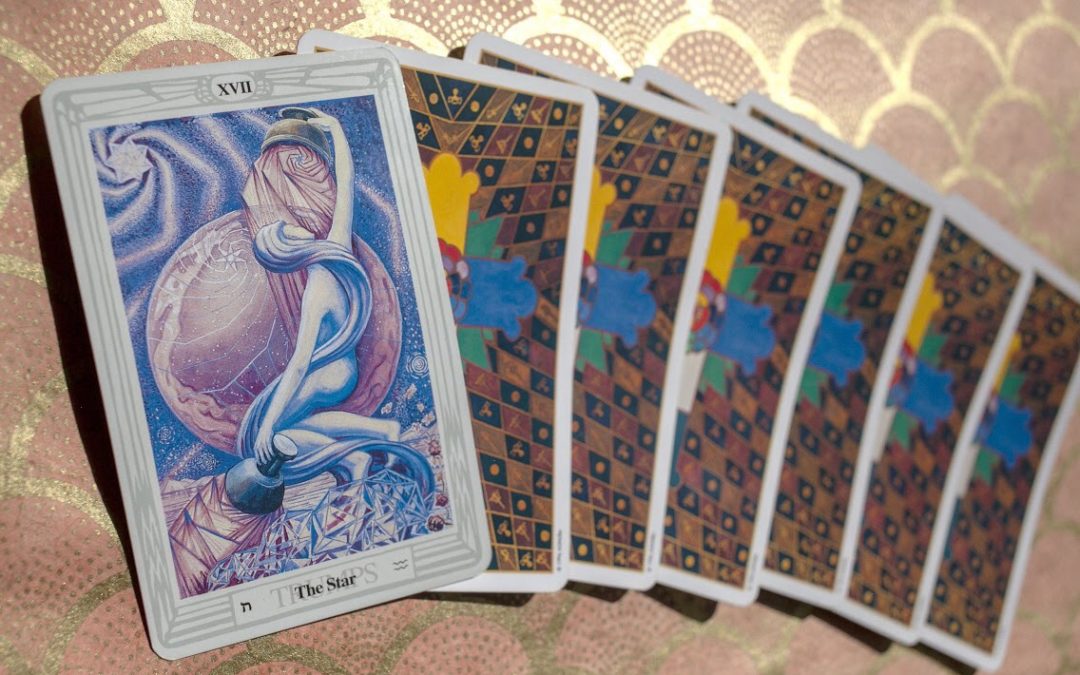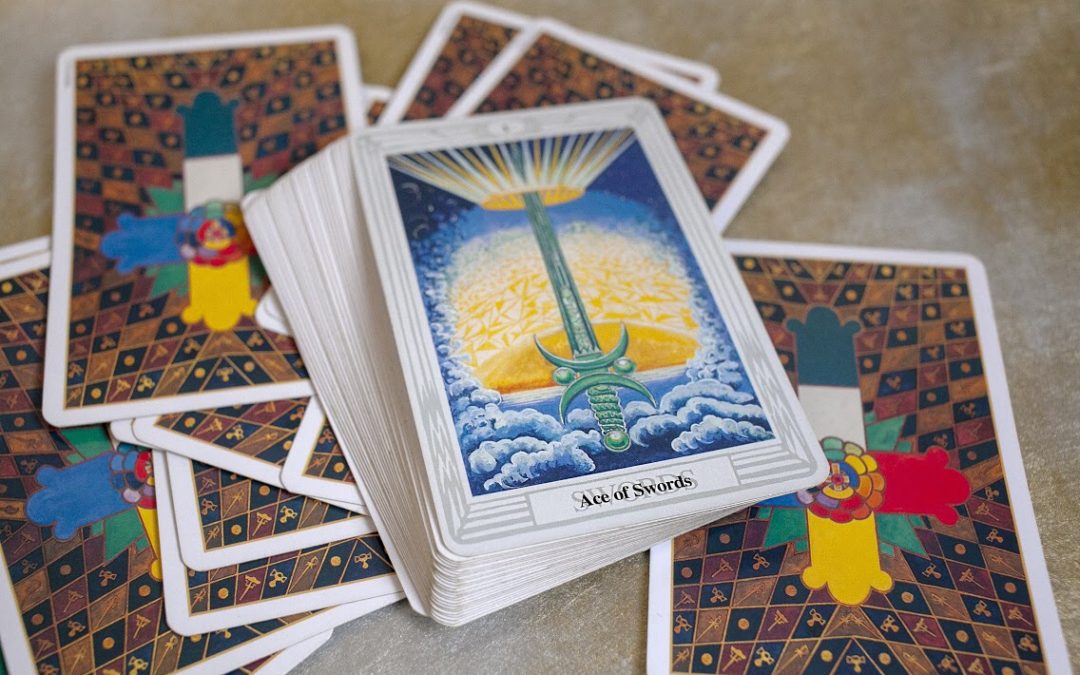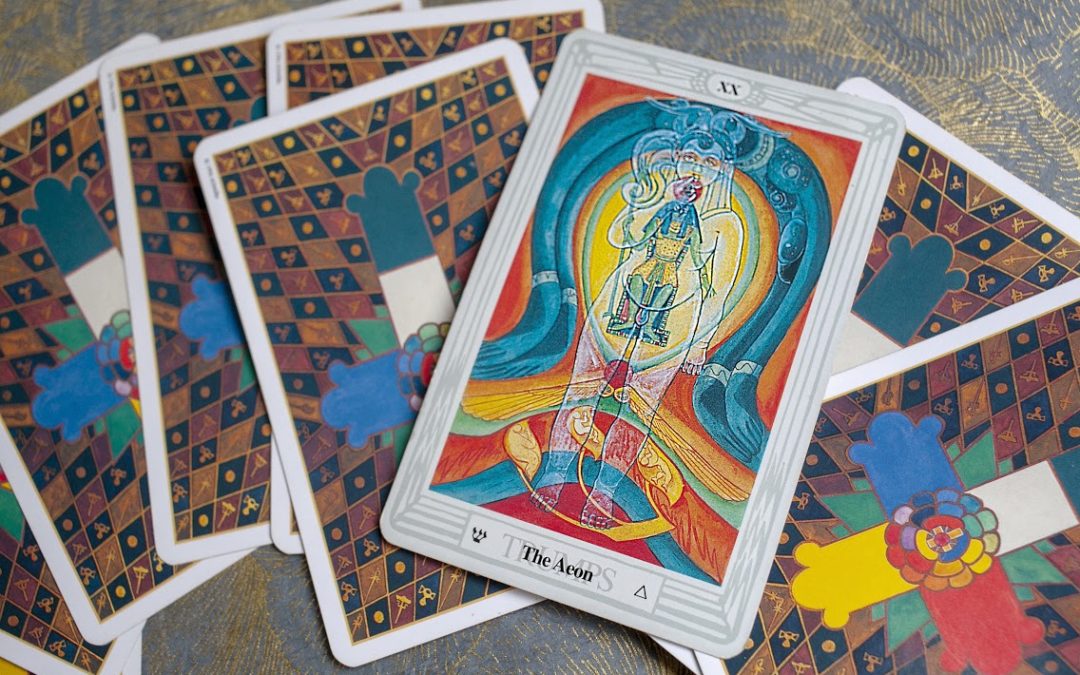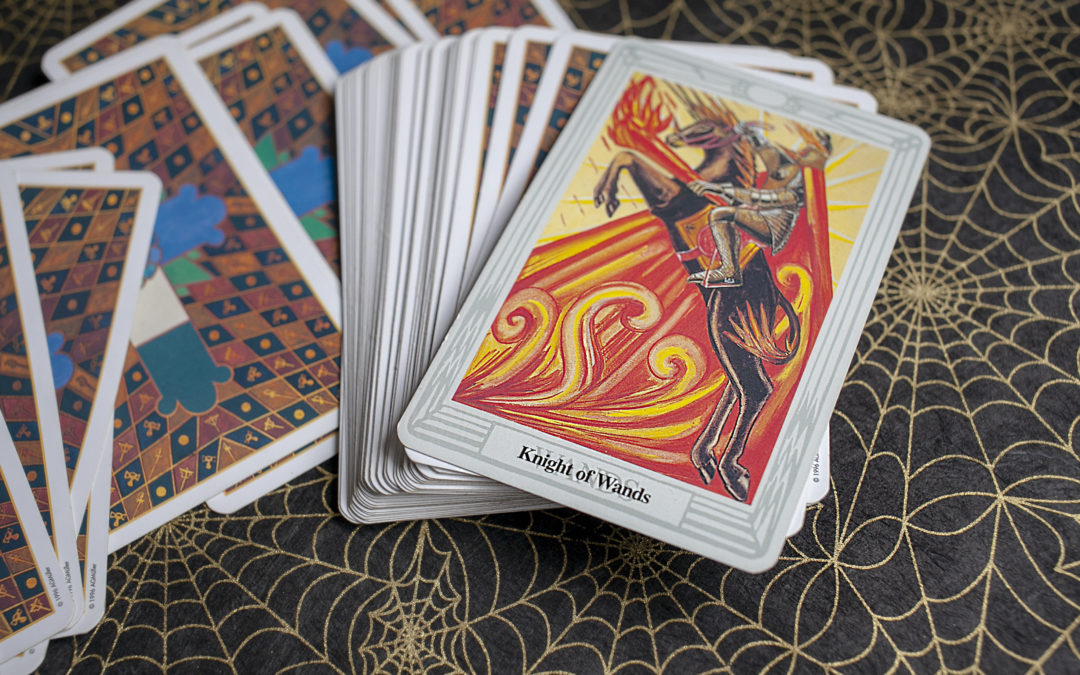
by Kosmic Tonic | Apr 29, 2019 | Tarot
No matter what deck you use, the Hermit never seems to look at you head-on. In this version, he buckles into the wheat, face barely even in profile. His hand forms the centre of the card, which is appropriate, given the Hebrew letter associated with the Hermit is Yod (י), which translates to “hand.” This letter has been said to represent the “divine spark”: “the first dot with which the scribes first start writing a letter, or the last dot that gives a letter its final form,” according to the Likutei Maharan.
The grapheme of the Yod, that diminutive tick, forms the foundation of all Hebrew letters—as all written words begin with a hand.
I’ve always associated the sign Virgo with the hand: the hand writing or weaving, the precision and sensitivity of our fingers, which no machine can quite replace or replicate. Our hands opened in offering or clasped in prayer or simply feeling forward. The astrological correspondence of this card is, indeed, Virgo. When that thought truly landed for me, it changed how I conceived the word virgin.
It has been said that the pre-patriarchal definition of “virgin” described someone who was independent and self-sovereign. This theory resonates, though I can’t find a historical or etymological backing for it. In all likelihood “virgin” from “virgo” described simply a girl.
Today, the words Hermit and Virgin both suggest someone un-coupled, in a state of seclusion or retreat. The only difference is we conceive the virgin as somehow in-waiting, “eligible.” If we divorce, for the moment, chastity from the idea of goodness (and from the quasi-imperial fetishization of conquering “unspoilt” or “unclaimed” bodies), Virgin and Hermit are the same. Both turned from the world, maybe inward or upward, or backward or forward, like the 3-headed Cerberus on this card. But importantly: not at you.
Demetra George has written of Vesta as complete-in-herself, her libido flowing divinely upward rather than to another person. And here enters an alternative understanding of the Hermit: as priestess or seeker. The Fool on her journey toward knowing. In the language of witchcraft, new students are described, simply, as seekers.
Though I understand the hesitation to conflate signs with houses—and assume co-equivalence between Virgo and the 6th house—there is a meaningful echo here. I connect the 6th house to ritual: the humility of sweeping a practice space, cleaning the altar, polishing the chalice. Opposite the 6th is the 12th house: that space of seclusion and study, shadow work, occasional dark nights.
Aleister Crowley connects this card to the Persephone story. He evokes Mercury (ruler of Virgo) as Psychopomp, our guide into Other or Underworlds. This is a common theme: the virgin (or seeker or hermit) entering the shadow realm, the nether regions of their mind or spiritual quest. In the story, Ceres / Demeter destroys our crops in her rage and grief and desperation to return her daughter from Hades. She’s successful, in part. But Persephone, as we knew her, has changed. She’ll return to the underworld again next winter, and with her, the crops will freeze. Interesting, the background of wheat in this card, especially when you note that the brightest star in the constellation of Virgo is Spica, which is Latin for “ear of grain.”
According to Crowley, this card represents fertility in its most exalted sense, not to be mistaken with the narrow, procreative definition of the word. Rather, he means fertility as potential, more perfect because it is unformed. Fertility as yod or hand or divine spark. And so, I can’t see the Virgin as a maiden-in-waiting or a glorified Bachelorette. She’s the Hermit, the Nun, the Priest, the Thinker, the Creatrix, hands busied in weaving, writing, offering and prayer.

by Kosmic Tonic | Mar 23, 2019 | Tarot
Here we find Nuit / Nuith / Nut, the Goddess of Night in her manifest (that is, physical) form. We studied this figure in our exploration of the Aeon card, which featured Nuit in her “formless form,” back-bending in infinite space over Horus. That tension between form and formlessness feels appropriate for the major arcana card that corresponds to Aquarius: a sign of the least embodied element (air), ruled by Saturn, who deals in structure.
As in the Rider-Waite-Smith rendition of the card, the sign Aquarius arrives in the shape of the water bearer: the figures in both decks occupied in the labour of pouring. In the R.W.S. version, the woman kneels with one foot on the earth, the other under-water, implying a bridge between form and formlessness, or boundaries and boundaryless-ness. I’ll come back to this bridge, for it captures something of the essence of Aquarius.
Crowley linked this card to the Hebrew letter heh, which means window. As the author at Esoteric Meanings points out, a window’s main function is to transfer light: like the stars (or our stars, the sun.) When considering the sign of Aquarius, I am taken with how light might also represent knowledge or “enlightenment.”
The R.W.S. version of this card features an eight pointed star, which is mythologically associated with the Star of Ishtar or Inanna (and thereby Venus.) This makes sense for an astrologer, because we know planetary Venus draws her own star around the ecliptic in eight year cycles. Crowley’s star has seven points, which is known as the Elven or Fairy star (and used as a symbol of the A.A, the inner order of the O.T.O., of which Crowley was one of the most famous members.) Again, as an astrologer, I associate seven with the planet Saturn, the 7th “wandering star” counted in traditional astrology. Of course, we also count his cycle in seven year increments, or Saturn squares. Interestingly, Crowley links the seven-pointed star to Venus as well, as Venus rules the 7th sphere on the Tree of Life: Netzach.
This blurring between Venus and Saturn feels significant, as it catches on the inherent tension of this card, one of the most aesthetically “feminine” and nocturnal in the deck, though it correlates to a traditionally “masculine” and diurnal sign. In his Book of Thoth, Crowley describes the water in the background of this card as the “great sea of Binah,” the 3rd sphere on the Tree of Life, which relates to intuitive understanding, contemplation, and the womb that gives shape to the spirit of God. What is the planet we associate with this sphere? None other than Saturn.
That Saturn might be considered a feminine planet is not a new concept in astrology. In the Hellenistic text, Carmen Astrologicum, Dorotheus says: “…the feminine planets are Saturn, Venus and the Moon, the masculine ones are the Sun, Jupiter, and Mars.” Though Dorotheus is the only astrologer who asserts the femininity of Saturn (to my knowledge), the notion does offer a pleasing symmetry between the nocturnal / diurnal and masculine / feminine planets. For more information on the theory of Saturn as a feminine planet, and particularly Saturn as Crone, check out Charles Obert’s excellent discussion on the subject at Student of Astrology.
This polarity between diurnal and nocturnal is further represented on the card between the gold and silver chalices: the former, solar, the latter lunar, or even Saturnian. Indeed, this imagery calls to mind the axis between sun-ruled Leo and his opposite: wintry, Saturn-ruled Aquarius. As suggested earlier, there is an inherently bridging quality in the archetype of Aquarius. Many Aquarians I know take for granted the assumption (radical for some) that we should share, cooperate, freely exchange our efforts and our ideas. On the one hand, Aquarius is independent, free-spirited, intellectually expansive, as represented by the Air element. On the other hand, Aquarius is fixed in belief, tethered to logic, if their own, ingeniously innovated. This sign is the water-bearer, but not water. Aquarius conveys the water of knowledge in the Saturn structure of two vessels or cups.
In his Book of Thoth, Crowley suggests that to understand this card, one must understand the first chapter of the Book of the Law, which chronicles the manifesting of Nuit and her masculine counterpart, Hadit. Several lines from this text underline the divinity and uniqueness in all of us, another egalitarian (and Aquarian) concept. Crowley writes: “every man and every woman is a star,” and later: “For he is ever a sun, and she a moon. But to him is the winged secret flame, and to her the stooping starlight.” In the mouth of Nuit, Crowley continues: “I am the blue-lidded daughter of Sunset; I am the naked brilliance of the voluptuous night-sky.”
In addition to heh, The Star has been linked to the Hebrew letter tzaddi, which means fish hook. Traditionally, tzaddi has also been assigned to the Emperor, and the two cards appear interchangeable in the Golden Dawn list of correspondences. In The Law is For All, Crowley writes: I see no harm in revealing the mystery of Tzaddi to ‘the wise’; others will hardly understand my explanations. Tzaddi is the letter of The Emperor, the Trump IV, and He is the Star, the Trump XVII. Aquarius and Aries are therefore counterchanged, revolving on the pivot of Pisces, just as, in the Trumps VIII and XI, Leo and Libra do about Virgo. This last revelation makes our Tarot attributions sublimely, perfectly, flawlessly symmetrical.
I won’t spend more on the Golden Dawn correspondences between the Hebrew letters and the tarot keys, but again I find it worth pausing on, this symmetry and swapping between genders: The Star for the Emperor; the Goddess of Night as Aquarius; the womb, Binah, as Saturn. It does feel appropriately Aquarian, this defying of convention, at once rigid in its logic and contra-normative.
Angeles Arrien’s description for The Star quotes Heidegger, who says: “a person is not a thing or a process, but an opening through which the Absolute can manifest.” Arrien elaborates on this sentiment: “the Star card reminds us that each of us is an opening for light, or a gateway through which the Absolute can manifest.” That is God, or divinity, or Spirit.
If any sign recognizes the divinity in all of us, and the collective light that pools when we work together, it is Aquarius. And maybe that contributes to the feminine thread of Saturn: the wise woman goddess who sees herself reflected in you, the womb as a pliant container for life, but ultimately, still a structure.
References:
Liber AL vel Legis by Aleister Crowley
The Book of Thoth by Aleister Crowley
The Law is For All by Aleister Crowley
Student of Astrology by Charles Obert
Esoteric Meanings

by Kosmic Tonic | Mar 16, 2019 | Tarot
The Ace of Swords is the root of the Air element: the purest essence of Air, which we associate with the mind, words, and law. For what is law but language? Indeed, θέλημα, or “THELEMA” is inscribed on the blade: the Greek word for “will,” or “the word of the law” for Crowley. Immediately, I think of the Sword of Justice in the Adjustment (or Justice) card. And the Queen of Swords, a head dangling from her fist. That ruthless, stone-eyed face the law can have: “blind,” in theory, for better or worse.
Some of the symbolism on this card is difficult to grasp if you’re not familiar with the Kabbalah. It is said that Air is formed from the union of Fire and Water: and so we see the sun rising from the lake or ocean, the clouds sudsing around it. Maybe you don’t need to know the Kabbalah to understand this one after all. What happens to water when we boil it?
The crown is lit by 22 rays: perhaps representing the 22 major arcana, or the 22 pathways of the Tree of Life. All of the aces correspond to Kether in the Tree: the topmost sphere, considered so sublime it’s completely incomprehensible (to us.)
A snake coils six times around the hilt, which is said to be of copper, Venus’ metal. There seems to be a symmetry implicit in that: Venus countering the violence of the sword. The crescent moons balancing the Sun on the water. We say a strong mind is “level-headed,” another word for balanced.
If you’ve dabbled in the Tarot, you’ll have noticed that many cards in the Sword suit have more negative or challenging connotations. In this deck, the Ten of Swords is captioned “Ruin,” the Five of Swords, “Defeat,” the Nine of Swords, “Cruelty,” and so on. It makes sense in a way. We only experience difficulty with our mind. As told in the old adages: “ignorance is bliss” (and so what is the opposite), or “curiosity killed the cat.” Once we turn our brains on and really examine the story we’ve found ourselves in, we get into trouble. A blue pill / red pill conundrum.
Red Pill: “a life of harsh knowledge, desperate freedom, and the brutal truths of reality.”
Blue Pill: “a life of luxurious security, tranquil happiness, and the blissful ignorance of illusion.”
The Ace of Swords seeds the air signs: Gemini, Libra, Aquarius. All of them cutting, in their way, wielding their minds as battle axes to learn, find justice (or balance), and project their ideals onto humanity.
The Ace of Swords can indicate a fresh idea. The light bulb moment. Epiphany. It is the root essence of honesty. Clear thinking. The sword severs, and this is a suit (or element) of detachment. The sword pierces the fugue of emotions. And yet, it’s not confined by the materiality of the earth element. It sees beyond corporal bodies, into the logic (and logos) of things. The Air element thinks, calculates, articulates. Articulate, from articulare, “to separate into joints.”
As the root of the Air element, the Ace of Swords seeks fairness, social justice, the truth. Another tired expression: the pen is mightier than the sword. So is the brain. Funny how the Air element represents all three.
If you surrendered to the air, you could ride it. -Toni Morrison

by Kosmic Tonic | Mar 4, 2019 | Tarot
This has been one of the hardest Thoth cards for me to tap into: partly because I’ve read so many conflicting interpretations. Angeles Arrien describes the central gods as Osiris, in child and adult forms. Except the falcon-headed god at the centre is unambiguously Horus, Osiris’ son. Even the gauzy child overlay resembles Horus the Child, who was depicted in statues as a naked boy with a finger pressed to his mouth. Interestingly, this hand position features in the Egyptian hieroglyph for “child.” It’s possible this symbol was actually misinterpreted by Greek and Roman poets to mean “silence.” And so Harpocrates, the Greek God adopted from Horus, became the God of secrecy.
To me, he still resembles a boy licking honey (or jam, or ice cream) off his finger.
I think, too, of the word “horizon.” How it seems to contain the words “Horus rising,” or even “Horus sun,” even if the etymological link is invented: symbolically pleasing, but ungrounded in history. It is true that Horus became the Egyptian Sky God, and that in child forum, he represented the newborn sun warming the dawn horizon.
Back-bending over child and adult Horus, is Nut (or Nuit or Nuith), the goddess of the night sky. Angeles Arrien describes her shape as the glyph for Leo. Angel Paths connects her form to the ankh symbol. Esoteric meanings calls it the omega. The latter seems most likely to me. The Aeon card correlates to “Judgment” in other decks, and the Omega echoes that Biblical imprint: “I am the Alpha and the Omega, the first and the last, the beginning and the end.”
And I suppose that’s where the interpretation really begins for this card: both its iteration in more traditional decks as “Judgment,” and here as the Aeon, or an immeasurable period of time. The card orbits the threshold between midnight and dawn; child and adult; life and pre-life, indicated by the fetal figures nestled in the Hebrew letter ש (pronounced “shin” or “shein.”)
Crowley’s religion, Thelema, identified three aeons: the Aeon of Isis, the Aeon of Osiris, and now, the Aeon of Horus, defined by self-realization and self-actualization. It aligns closely with our conception of the Age of Aquarius: a sort of idealizing of our present potential and the future we’re tipping into.
In Little Essays Toward Truth, Crowley writes: The Aeon of Horus is here: and its first flower may well be this: that, freed of the obsession of the doom of the Ego in Death, and of the limitation of the Mind by Reason, the best men again set out with eager eyes upon the Path of the Wise, the mountain track of the goat, and then the untrodden Ridge, that leads to the ice-gleaming pinnacles of Mastery.
So what does this all add up to?
Time. Self-evaluation and evolution. Potential.
A theme of triplicity dominates this card. There’s no obvious link to any of the signs or planets of the zodiac, but a trine symbol (△) at the bottom right, opposite the Hebrew ש (“shin.”) According to Rabbi Aaron L. Raskin, the three vertical lines of ש represent the three dimensions of a human being: kesser (will and pleasure), the intellect and emotions.
Shin has fine definitions in Hebrew. The one Crowley focuses on is “tooth.” I first interpreted this in a threatening way… the “tooth” of judgment like the “fist” of Saturn, or some other punishing body part. But there’s also the connotation of chewing your food before you eat it: chewing over an idea before you act.
When you combine all of these symbols together: Horus, the three aeons, Night in wheel pose, the fetal figures painted in the golden rod ש, alongside the traditional interpretation of this card as Judgment, the key message seems to be: only you are responsible for your own thoughts, action and evolution. The author at Angel Paths phrases it well when she says: The Aeon forces us to acknowledge that our actions set up a chain of cause-and-effect for which we are solely responsible. Here we pass through the fire of purification, shedding dead and dying wood as we go. We judge ourselves frankly, forgive, and leave the past behind.
There is a theme of archways. Of passing through. Not passively awaiting our day of judgment, but turning an eye onto our own patterns, our own participation in games.
As Camus writes in The Fall: I shall tell you a great secret, my friend. Do not wait for the Last Judgment. It takes place every day.
When this card comes up in readings, it may indicate a turning point. A moment where you pass into a new phase (or aeon.) All of your decisions and actions until now have led to this moment. You are your own gatekeeper. Trust yourself.
References:
Camus, Albert. The Fall.
Crowley, Aleister. The Book of Thoth.
Crowley, Aleister. Heart of the Master.
Raskin, Aaron. “Shin—The Matriarchs.”
Angel Paths
Esoteric Meanings

by Kosmic Tonic | Feb 6, 2019 | Tarot
On first glance, the black steed rears from a lake of fire. And then you realize fire is climbing the Knight’s cape—indeed he is cloaked in flames— , and flares shoot from his helmet in a sort of eyebrow-singeing visor. To say nothing of the enflamed torch emerging from his groin area: the ace of wands. As the cards go, this one’s pretty masculine.
In the Thoth deck, the Knight is the highest court card: equal to Kings in other decks. And so, the Knight of Wands represents fire in its most advanced form. According to Crowley, this Lord of Flame and Lightning rules 21° Scorpio to 20° Sagittarius. His wand represents his vision: the truth he wishes to share with the masses. Fire signs don’t keep their truths to themselves: they yearn to burn outwards, to gather others around their heat. In this way, the card does call to mind Sagittarius. The Knight is on a mission. He’s energetic: we’re talking teenaged-levels of virility. He’s combustible. Before the dank mould of self-doubt creeps in, he will burn all spores of uncertainty in his path.
And maybe he’s not a he. The King of Wands might represent that part of you that has mastered vision and vitality (according to Angeles Arrien), or other fire themes, such as creativity. This archetype is relentlessly optimistic. Buoyant. Surging.
It’s appropriate Crowley linked this Knight to Scorpio too, for the imagery on this card is uncompromisingly Martian. The reds and yellows. The phallic torch. The fire. The focus and thrusting forward.
But there’s a danger to unyielding self-belief. It results in dogma. Cultural genocide. Tyranny. The Knight of Wands could be lifted from a Crusades painting: man on horse, wielding his creed. This Knight is unmitigated by the other elements: such as the empathy of water, the detachment of air, the discernment of earth. We’ve seen the results of unmitigated fire before: it doesn’t stop eating.
So with this card, take the green light, but bring your own caution. Pace yourself. Unlike the Knight of Wands, your birth chart has the in-built support system of more than one element.
Repeat after Borges: Time is the substance from which I am made. Time is a river which carries me along, but I am the river; it is a tiger that devours me, but I am the tiger; it is a fire that consumes me, but I am the fire.
And Maxine Hong Kingston:In a time of destruction, create something.





